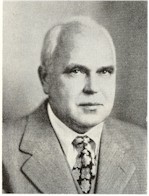Harald T. Friis
Harald T. Friis: Biography
Born:1893
Died: 1976
Harald T. Friis was born in 1893 in Naestved, Denmark, and graduated in electrical engineering from the Royal Technical College in Copenhagen in 1916. He then spent about two years at the Royal Gun Factory in Copenhagen. In 1919 he received a fellowship which enabled him to come to the United States where he studied radio engineering at Columbia University under John H. Morecroft. In 1920, Friis joined a research group headed by Edwin H. Colpitts at the Western Electric Company, a group which became part of Bell Laboratories in 1925.
Friis initially was assigned to investigate radio reception from ships at a station in Elberon, NJ. He designed a double-detection superheterodyne receiver and undertook a long series of measurements of field strength and noise over a wide range of frequencies. He developed techniques to compensate for signal fading and used oscillographs to determine phase differences and other propagation phenomena. He and two colleagues published an important IRE paper on radio transmission measurements in 1923. They stressed the need to measure signal to noise ratio rather than field strength alone and discussed how to achieve satisfactory radio communication while minimizing equipment cost. Friis published further results of his research in his December 1925 IRE paper on directional antennas, in a 1926 paper on the static recorder in the Bell System Technical Journal, and in a May 1928 IRE paper on oscillographic observations.
Friis assisted in the design of the receiving system used by his colleague, Karl Jansky, to detect and record galactic radio noise in the early 1930's. These observations launched the new science of radio astronomy. Friis and Edmond Bruce were co-inventors of the rhombic antenna which came into wide use as a shortwave antenna. Friis subsequently designed a multiple-unit steerable antenna (MUSA) which employed an array of rhombics and was altered for optimum reception of shortwave signals. He received the Morris N. Liebmann Award of the IRE in 1939 in recognition of his many contributions to radio science and engineering.
In 1938, Friis became the director of a research team at the Holmdel laboratory facility of Bell Labs with the mission of developing microwave systems. He and a colleague, Alfred C. Beck, designed a horn-reflector antenna which became widely used. The Holmdel group went on to develop both microwave radar and communication equipment used by the military during World War II. Friis invented an ingenious "rocking horse" mechanical scanner for a radar set used to locate enemy mortars. In a May 1946 IRE paper, he disclosed a radar transmission formula which had proven useful to the group at Holmdel. A microwave relay network based on their work was installed for commercial use in the US soon after the war.
Friis was also widely recognized for his leadership skills. He did not seek attention and thus often did not gain acclaim for his own important work. He was a more natural collaborator, and his assistance to others was deeply appreciated. His work as a teacher and supervisor was seen as invaluable; conversations with Friis frequently helped other engineers sharpen their work and make great progress.
In 1954, Friis received the Valdemar Poulsen Medal of the Danish Academy of Sciences. The following year, he received the IRE Medal of Honor, "For his outstanding technical contributions in the expansion of the useful spectrum of radio frequencies, and for the inspiration and leadership he has given to young engineers." He also received the Ballentine Medal from the Franklin Institute in 1958 and the Mervin Kelly Award of the IEEE in 1964. He retired from the Bell Labs in 1958 but continued work as a research consultant to the Hewlett-Packard Company for the next decade. His autobiography, entitled Seventy Five Years in an Exciting World, was published by the San Francisco Press in 1971. He died in 1976 at age 83.
